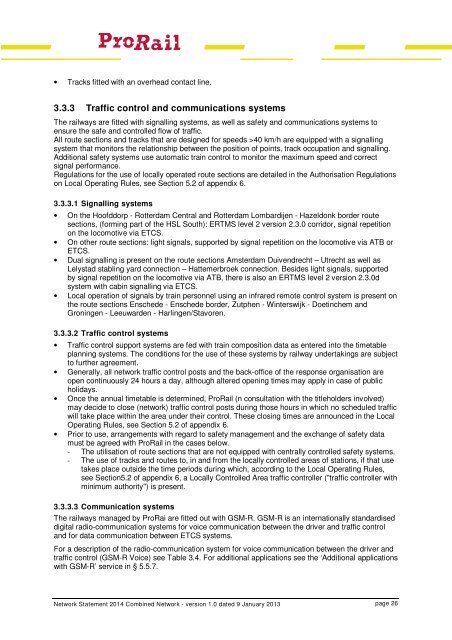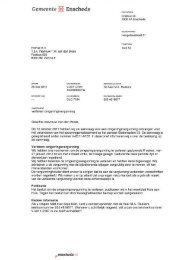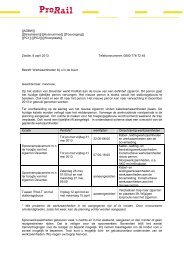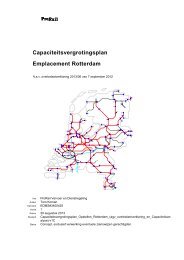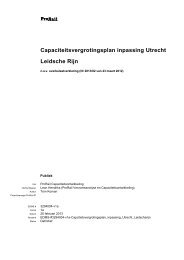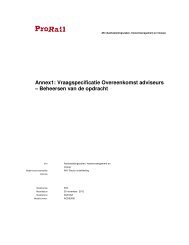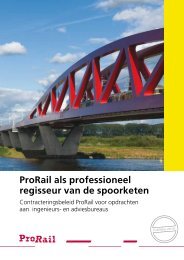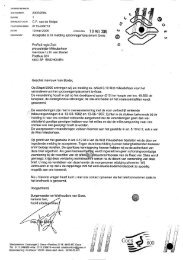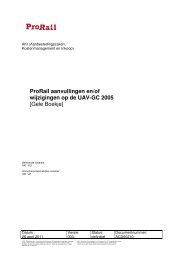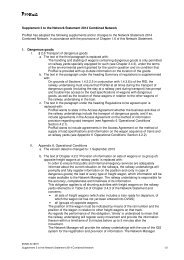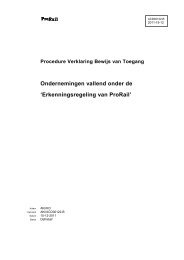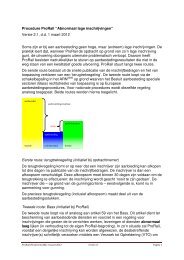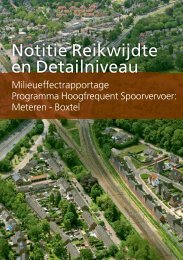Network Statement 2014 - ProRail
Network Statement 2014 - ProRail
Network Statement 2014 - ProRail
- No tags were found...
You also want an ePaper? Increase the reach of your titles
YUMPU automatically turns print PDFs into web optimized ePapers that Google loves.
• Tracks fitted with an overhead contact line.3.3.3 Traffic control and communications systemsThe railways are fitted with signalling systems, as well as safety and communications systems toensure the safe and controlled flow of traffic.All route sections and tracks that are designed for speeds >40 km/h are equipped with a signallingsystem that monitors the relationship between the position of points, track occupation and signalling.Additional safety systems use automatic train control to monitor the maximum speed and correctsignal performance.Regulations for the use of locally operated route sections are detailed in the Authorisation Regulationson Local Operating Rules, see Section 5.2 of appendix 6.3.3.3.1 Signalling systems• On the Hoofddorp - Rotterdam Central and Rotterdam Lombardijen - Hazeldonk border routesections, (forming part of the HSL South): ERTMS level 2 version 2.3.0 corridor, signal repetitionon the locomotive via ETCS.• On other route sections: light signals, supported by signal repetition on the locomotive via ATB orETCS.• Dual signalling is present on the route sections Amsterdam Duivendrecht – Utrecht as well asLelystad stabling yard connection – Hattemerbroek connection. Besides light signals, supportedby signal repetition on the locomotive via ATB, there is also an ERTMS level 2 version 2.3.0dsystem with cabin signalling via ETCS.• Local operation of signals by train personnel using an infrared remote control system is present onthe route sections Enschede - Enschede border, Zutphen - Winterswijk - Doetinchem andGroningen - Leeuwarden - Harlingen/Stavoren.3.3.3.2 Traffic control systems• Traffic control support systems are fed with train composition data as entered into the timetableplanning systems. The conditions for the use of these systems by railway undertakings are subjectto further agreement.• Generally, all network traffic control posts and the back-office of the response organisation areopen continuously 24 hours a day, although altered opening times may apply in case of publicholidays.• Once the annual timetable is determined, <strong>ProRail</strong> (n consultation with the titleholders involved)may decide to close (network) traffic control posts during those hours in which no scheduled trafficwill take place within the area under their control. These closing times are announced in the LocalOperating Rules, see Section 5.2 of appendix 6.• Prior to use, arrangements with regard to safety management and the exchange of safety datamust be agreed with <strong>ProRail</strong> in the cases below.- The utilisation of route sections that are not equipped with centrally controlled safety systems.- The use of tracks and routes to, in and from the locally controlled areas of stations, if that usetakes place outside the time periods during which, according to the Local Operating Rules,see Section5.2 of appendix 6, a Locally Controlled Area traffic controller ("traffic controller withminimum authority") is present.3.3.3.3 Communication systemsThe railways managed by ProRai are fitted out with GSM-R. GSM-R is an internationally standardiseddigital radio-communication systems for voice communication between the driver and traffic controland for data communication between ETCS systems.For a description of the radio-communication system for voice communication between the driver andtraffic control (GSM-R Voice) see Table 3.4. For additional applications see the ‘Additional applicationswith GSM-R’ service in § 5.5.7.<strong>Network</strong> <strong>Statement</strong> <strong>2014</strong> Combined <strong>Network</strong> - version 1.0 dated 9 January 2013 page 26


